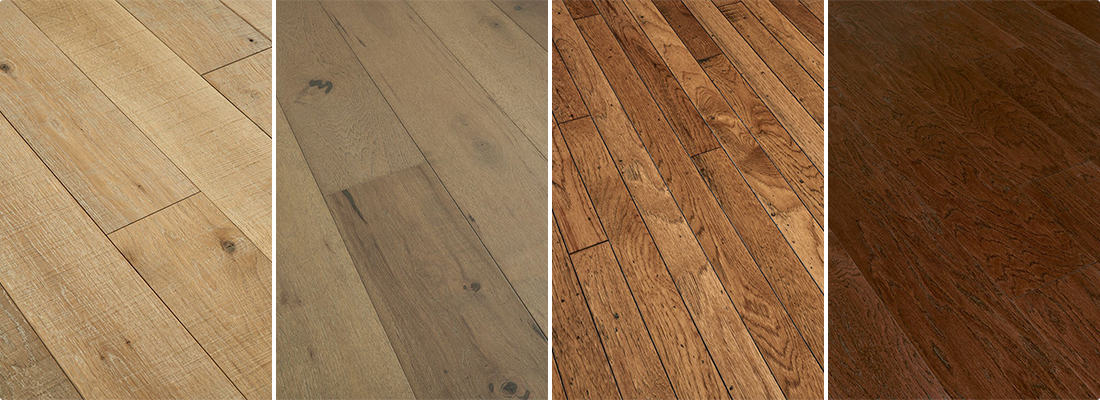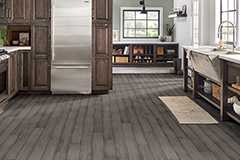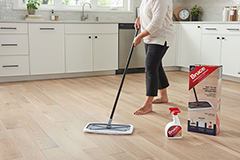How to Choose a Hardwood Flooring Color
It’s a daunting task – how to choose a flooring color. But here are some tips to help you decide. Find out how light versus dark colors can impact your design.
July 19, 2023 | By Bruce Design Expert
You’ve decided to install hardwood flooring in a space. That’s an easy decision considering its popularity, durability, and timelessness. But now comes the hard part. How to choose a flooring color.
Goodness knows there are so many colors available. Plus, if you can’t find the perfect match at a local home or flooring center, you can install unfinished hardwood. Then, you can stain or paint the flooring to achieve your desired color.
So how do you choose a hardwood flooring color?
Choosing a Light vs. Dark Hardwood Color
Choosing a hardwood flooring color comes down to one thing — you. There’s no right or wrong color. The only color that matters is what you like (unless you’re a stickler for resale value).
To start, there are pros and cons to selecting lighter versus darker flooring colors. Here’s a snapshot of each and their impact.
Light Hardwood Floors
-
Natural Look
-
Hides dirt, scratches & light-colored pet hair
-
Makes smaller spaces appear larger
-
Casual, light feel
-
Works well with darker furniture
-
Flexible design style
-
Shows imperfections
Dark Hardwood Floors
-
Adds depth and contrast
-
Shows dirt and scratches but hides dark-colored pet hair
-
Makes smaller spaces feel smaller
-
Elegant, warm feel
-
Works well with lighter furniture
-
Flexible design style
-
Hides imperfections
Regarding specifics for choosing a floor color, here are some tips to help. So you won’t have to run to an interior designer for help.
Tip 1: Determine Your Room’s Focal Point
Some people want their flooring to be the shining star of the room. Others prefer having their hardwood flooring take a backseat so that the room’s walls and furnishings anchor its color scheme.
So which do you prefer?
Natural flooring colors provide a neutral base that allows the room’s other elements to shine. Consequently, you’ll want to choose colors such as white, gray, and beige. You can even install natural hardwood and add a clear finish.
Best of all, these fit today’s design color trends. And despite being trendy, most are considered timeless.
White Oak flooring typically features more natural tones, letting your room’s décor take center stage. It’s also one of the most popular flooring options among homeowners.
Conversely, if you want your floors to be the main attraction, go with bolder, darker tones like brown, darker grays, and reds. Dark floors bring a room a classic, elegant look while offering contrast. That contrast is especially noticeable paired with lighter-colored furnishings.
It’s also interesting that darker-colored wood fades less than light-colored hardwoods. That’s a plus if you have a room with substantial natural light, where the UV rays can discolor your floors.
Hickory flooring offers bolder colors, not to mention unique graining that draws your eye to the flooring in a space.
Tip 2: Consider the Amount of Natural Light
Speaking of natural light, it’s beneficial to consider the amount of light your room gets.
For example, if the space receives little natural light, a lighter floor helps to open up the room. So again, you’ll want to stick with white, grays, beiges, blondes, and other natural colors.
On the other hand, if the room receives plenty of natural light, your color palette expands considerably. The choice is all yours.
Tip 3: Think About Your Lifestyle When Considering Hardwood Colors
Choose hardwood flooring colors that mirror your lifestyle. For example, lighter flooring with a matte finish makes sense if you have an active lifestyle with kids and pets. Why?
Lighter floors don’t show dust as much as darker floors. Moreover, they also hide scratches and dents better. So, your hardwoods will look better more often than not.
Light hardwood colors also create a more casual look that complements an active lifestyle.
Although dark hardwood shows the wood’s grain better than lighter flooring, it also presents scratches and dust more clearly. That’s especially true when combined with a higher gloss finish.
So, that means you’ll have to clean your floors more often than a lighter-colored floor. That said, if you have a dark-haired dog, a darker base will better hide that than lighter flooring. Even so, it will still show scratches and dust more readily.
Tip 4: Select a Hardwood that Matches Your Lifestyle
Apart from flooring color, you’ll also want to consider the type of flooring you install if you have an active lifestyle, especially with pets.
In that case, look for flooring featuring scratch-resistant hardwood. You’ll also want flooring with some measure of water resistance. Bruce, for example, recently released dog-friendly hardwood flooring, Dogwood®.
Dogwood uses a unique process to create hardened, densified wood. It makes the flooring 4X more scratch and 6X more dent resistance than standard solid or engineered hardwood. Additionally, it’s waterproof for up to 24 hours to protect against pet accidents to prevent floors from staining.
Dogwood is available in 13 colors, so have plenty of flooring colors to match your style. It’s an ideal wood flooring choice for high-traffic areas of your home.
Tip 5: The Size of Your Room Impacts Hardwood Flooring Color
Your flooring color can make a room look bigger or smaller. In some ways, it goes hand-in-hand with natural lighting.
If you have a small, poorly lit room, stick with color schemes using lighter colors – white, beige, gray, creams, etc. The light color provides the illusion of more significant space.
You can add to that by running wider floor planks parallel to the room’s longest wall. A gloss finish can also help.
If your heart is set on darker flooring in a smaller room, all is not lost. Here are some tricks to use dark colors but still make the room feel sizeable:
-
Use light paint on the walls, like grays, whites, and blues.
-
Use white paint on the ceiling and baseboards.
-
Add light area rugs
-
Keep the amount of furniture to a minimum
-
Add mirrors
You can also make a small room look larger using one flooring for all rooms. It creates a seamless flow from room to room to expand its appearance.
Bruce Offers More Than 350 Hardwood Flooring Options
Whether you prefer solid or engineered hardwood, you won’t have a problem finding a hardwood flooring color that fits your style. Bruce offers more than 350 options in various finishes.
You can select from numerous species: ash, birch, cherry, hickory, maple, white and red oak, and walnut. Plus, get a look to complement your décor, including traditional, distressed, brushed, and hand-scraped wood.
Use our hardwood flooring visualizer to find the best color for your room. In addition, our store locator will help you find the closest Bruce dealer to you.

Ready to shop for floors near you?
Use our retail locator to find where you can buy Bruce flooring products.
Find a Store

 Solid vs Engineered Hardwood Flooring
Solid vs Engineered Hardwood Flooring Guide To Choosing a Hardwood Floor
Guide To Choosing a Hardwood Floor Hardwood Flooring Room Inspiration Guide
Hardwood Flooring Room Inspiration Guide 10 Things to Know About Hardwood Floor Installation
10 Things to Know About Hardwood Floor Installation How To Clean and Protect Hardwood Flooring
How To Clean and Protect Hardwood Flooring